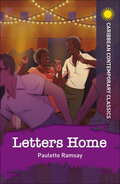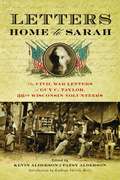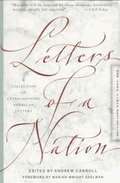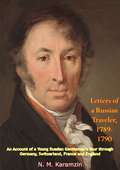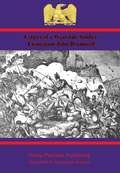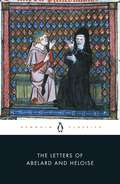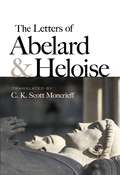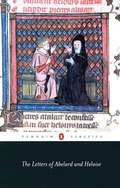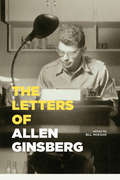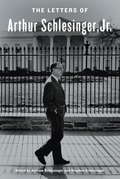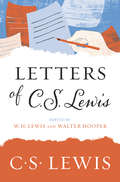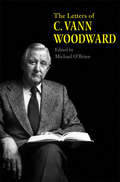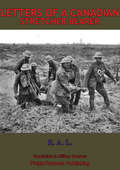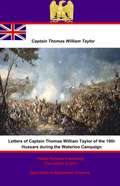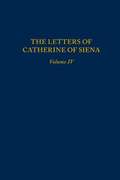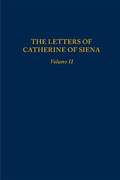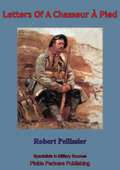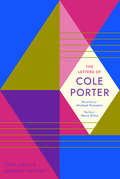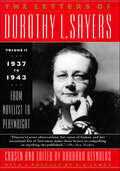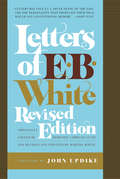- Table View
- List View
Letters Home (Caribbean Modern Classics)
by Ramsay RamsayThere have been many great and enduring works of literature by Caribbean authors over the last century. The Caribbean Contemporary Classics collection celebrates these deep and vibrant stories, overflowing with life and acute observations about society.Empire Windrush has long had an iconic status in British and Caribbean history. This book, largely told in the form of diary entries and letters home, reveals the day to day experience of the first immigrants, and the far-reaching effects on their lives and relationships. Jen has left a young daughter, Sunshine, in Jamaica, and in these letters to her daughter, she attempts to make sense of the dislocation and displacement she experiences, her response, and the effect on those close to her. A companion novel to Aunt Jen, Letters Home is a penetrating and devastating study of the immigrant experience in 1960s Britain, and its long-lasting consequences.Suitable for readers aged 16 and above.
Letters Home to Sarah
by Guy C. TaylorForgotten for more than a century in an old cardboard box, these are the letters of Guy Carlton Taylor, a farmer who served in the Thirty-Sixth Wisconsin Volunteer Infantry Regiment in the American Civil War. From March 23, 1864, to July 14, 1865, Taylor wrote 165 letters home to his wife Sarah and their son Charley. From the initial mustering and training of his regiment at Camp Randall in Wisconsin, through the siege of Petersburg in Virginia, General Lee's surrender at Appomattox, and the postwar Grand Review of the Armies parade in Washington, D. C. , Taylor conveys in vivid detail his own experiences and emotions and shows himself a keen observer of all that is passing around him. While at war, he contracts measles, pneumonia, and malaria, and he writes about the hospitals, treatments, and sanitary conditions that he and his comrades endured during the war. Amidst the descriptions of soldiering, Taylor's letters to Sarah are threaded with the concerns of a young married couple separated by war but still coping together with childrearing and financial matters. The letters show, too, Taylor's transformation from a lonely and somewhat disgruntled infantryman to a thoughtful commentator on the greater ideals of the war. This remarkable trove of letters, which had been left in the attic of Taylor's former home in Cashton, Wisconsin, was discovered by local historian Kevin Alderson at a household auction. Recognizing them for the treasure they are, Alderson bought the letters and, aided by his wife Patsy, painstakingly transcribed the letters and researched Taylor's story in Wisconsin and at historical sites of the Civil War. The Aldersons' preface and notes are augmented by an introduction by Civil War historian Kathryn Shively Meier, and the book includes photographs, maps, and illustrations related to Guy Taylor's life and letters.
Letters My Mother Never Read: An Abandoned Child's Journey
by Jerri Diane SueckThe true story of Jerri, whose mother died when she was 8 and whose extended family wouldn't take care of her. Describes Jerri's time in foster care and a group home. Jerri eventually graduates from college and leads a successful life.
Letters of a Nation: A Collection of Extraordinary American Letters
by Andrew Carroll Marian Wright EdelmanLetters of a Nation is a collection of extraordinary letters spanning more than 350 years of American history, from the arrival of the Pilgrims to the present day. Many of the more than 200 letters are published here for the first time, and the correspondents are the celebrated and obscure, the powerful and powerless, including presidents, slaves, soldiers, prisoners, explorers, writers, revolutionaries, Native Americans, artists, religious and civil rights leaders, and people from all walks of life. From the serious (Harry Truman defending his use of the atomic bomb) to the surreal (Elvis Presley to Richard Nixon on fighting drugs in America), this collection of letters covers the full spectrum of human emotion, illuminates the American experience, and celebrates the simple yet lasting art of letter writing.
Letters of a Russian Traveler, 1789-1790: An Account of a Young Russian Gentleman’s Tour through Germany, Switzerland, France and England
by N. M. KaramzinDuring 1789-90, Nicholai Mikhailovich Karamzin, a young poet and short-story writer, toured Western Europe. On his return, he distilled his impressions in the form of travel letters. Letters of a Russian Traveler, 1791-1801, in which Karamzin’s impressions are woven into a wealth of information about Western European society and culture that he derived from wide reading, became a favorite of readers and was widely imitated.The most influential prose stylist of the eighteenth century, Karamzin shaped the development of the Russian literary language, introducing many Gallicisms to supplant Slavonic-derived words and idioms and breaking down the classicist canons of isolated language styles.
Letters of a Weardale Soldier, Lieutenant John Brumwell
by William Morley Egglestone Lieutenant John BrumwellThis ebook is purpose built and is proof-read and re-type set from the original to provide an outstanding experience of reflowing text for an ebook reader. There is something particularly affecting when reading the posthumously published letters of a soldier who has fallen in battle. The hope of a future rings out clear from John Brumwell's letters back to his family in the north of England whilst he toils in the Duke of Wellington's army in Spain and Portugal, only to be cut short in 1812, two years short of peace. Local historian William Eggleston unearthed these letters still held in the same locality that Lieutenant Brumwell's family lived and wove them into a short book which contains much of the fallen officers' family background and connecting narrative explaining the war during which the letters were written. A short but worthwhile read. Title - Letters of a Weardale Soldier, Lieutenant John Brumwell Author -- Lieutenant John Brumwell (????-1812) Editor -- William Morley Egglestone (1838-????) Text taken, whole and complete, from the edition published in 1912, Stanhope Co. Durham, by the editor. Original - iii and 103 pages. Illustrations - 8 illustrations.
The Letters of Abelard and Heloise: Tr. From The Original Latin And Now Reprinted From The Edition Of 1722
by Peter AbelardThe story of Abelard and Heloise remains one of the world's most celebrated and tragic love affairs. Through their letters, we follow the path of their romance from its reckless and ecstatic beginnings when Heloise became Abelard's pupil, through the suffering of public scandal and enforced secret marriage, to their eventual separation.
The Letters of Abelard and Heloise
by C. K. MoncrieffAbelard, a prominent twelfth-century theologian, is hired to tutor Heloise, a brilliant pupil who becomes his lover and the mother of his child. Although the two are secretly married, a misunderstanding leads to Abelard's castration by Heloise's uncle, followed by the lovers' permanent separation. Abelard retreats to a monastery and Heloise to a nunnery — and their subsequent correspondence captured the romantic imaginations of generations of readers. The letters offer insights into the thinking of Abelard, who ranks among the Middle Ages' foremost philosophers, and the spirited determination of Heloise, an early feminist. They have also excited ongoing controversy in terms of their historical content and significance. Translator C. K. Scott Moncrieff takes a modern approach to the correspondence, adding new significance to its reflection of medieval attitudes toward love, marriage, and religion.
The Letters of Abelard and Heloise
by Betty Radice M. T. ClanchyThe story of the relationship between Abelard and Heloise is told through the letters of Peter Abelard, a French philosopher and one of the greatest logicians of the twelfth century, and of his gifted pupil Heloise. Through their impassioned writings unfolds the story of a romance, from its reckless, ecstatic beginnings through to public scandal, an enforced marriage and its devastating consequences. They also offer insight into religious life in the Middle Ages. This is the revised edition of Betty Radice's translation, in which Michael Clanchy, the biographer of Abelard, updates the scholarship on the letters and the lovers. This volume includes Abelard's autobiography and his spiritual advice to Heloise and her nuns, as well as a selection of the 'lost love letters' of Abelard and Heloise, letters between Heloise and Peter the Venerable, two of Abelard's hymns, a chronology, notes and maps.
The Letters of Allen Ginsberg
by Bill Morgan Allen GinsbergThe best of poet Allen GinsbergOCOs correspondence with friends like Jack Kerouac and William S. Burroughs, edited by the authorOCOs longtime literary archivist. "
The Letters of Arthur Schlesinger, Jr.
by Arthur Schlesinger Stephen C. Schlesinger Andrew SchlesingerThis extraordinary collection gathers the never-before-seen correspondence of a true American original--the acclaimed historian and lion of the liberal establishment, Arthur Schlesinger, Jr. An advisor to presidents, two-time Pulitzer Prize winner, and tireless champion of progressive government, Arthur Schlesinger, Jr., was also an inveterate letter writer. Indeed, the term "man of letters" could easily have been coined for Schlesinger, a faithful and prolific correspondent whose wide range of associates included powerful public officials, notable literary figures, prominent journalists, Hollywood celebrities, and distinguished fellow scholars. The Letters of Arthur Schlesinger, Jr. reveals the late historian's unvarnished views on the great issues and personalities of his time, from the dawn of the Cold War to the aftermath of September 11. Here is Schlesinger's correspondence with such icons of American statecraft as Harry Truman, Adlai Stevenson, Hubert Humphrey, Henry Kissinger, Bill Clinton, and, of course, John and Robert Kennedy (including a detailed critique of JFK's manuscript for Profiles in Courage). There are letters to friends and confidants such as Eleanor Roosevelt, John Kenneth Galbraith, Gore Vidal, William Styron, and Jacqueline Kennedy (to whom Schlesinger sends his handwritten condolences in the hours after her husband's assassination), and exchanges with such unlikely pen pals as Groucho Marx, Sammy Davis, Jr., and Bianca Jagger. Finally, there are Schlesinger's many thoughtful replies to the inquiries of ordinary citizens, in which he offers his observations on influences, issues of the day, and the craft of writing history. Written with the range and insight that made Schlesinger an indispensable figure, these letters reflect the evolution of his thought--and of American liberalism--from the 1940s to the first decade of the new millennium. Whether he is arguing against the merits of preemptive war, advocating for a more forceful policy on civil rights, or simply explaining his preference in neckwear ("For sloppy eaters bow ties are a godsend"), Schlesinger reveals himself as a formidable debater and consummate wit who reveled in rhetorical combat. To a detractor who accuses him of being a Communist sympathizer, he writes: "If your letter was the product of sincere misunderstanding, the facts I have cited should relieve your mind. If not, I can only commend you to the nearest psychiatrist." Elsewhere, he castigates a future Speaker of the House, John Boehner, for misattributing quotations to Abraham Lincoln. Combining a political strategist's understanding of the present moment with a historian's awareness that the eyes of posterity were always watching him, Arthur Schlesinger, Jr., helped shape the course of an era with these letters. This landmark collection frames the remarkable dynamism of the twentieth-century and ensures that Schlesinger's legacy will continue to influence this one.Advance praise for The Letters of Arthur Schlesinger, Jr. "Arthur Schlesinger's letters are full of personal, political, and historical insights into the tumultuous events and enormous personalities that dominated the mid-twentieth century. Because he viewed them up close but with a historian's perspective, The Letters of Arthur Schlesinger, Jr. helps us all to more fully understand recent history."--President Bill Clinton
Letters of Ayn Rand
by Ayn RandThe publication of the letters of Ayn Rand is a cause for celebration, not only among the countless millions of Ayn Rand admirers the world over, but also among all those interested in the key political, philosophical, and artistic issues of our century. For there is no separation between Ayn Rand the vibrant, creative woman and Ayn Rand the intellectual dynamo, the rational thinker, who was also a passionately committed champion of individual freedom. These remarkable letters begin in 1926, with a note from the twenty-year-old Ayn Rand, newly arrived in Chicago from Soviet Russia, an impoverished unknown determined to realize the promise of the land of opportunity. They move through her struggles and successes as a screenwriter, a playwright, and a novelist, her sensational triumph as the author of The Fountainhead and Atlas Shrugged, and her eminence as founder and shaper of Objectivism, one of the most challenging philosophies of our time. They are written to such famed contemporaries as Cecil B. DeMille, Frank Lloyd Wright, H. L. Mencken, Alexander Kerensky, Barry Goldwater and Mickey SpillaneThere are letters to philosophers, priests, publishers, and political columnists; to her beloved husband, Frank O' Connor; and to her intimate circle of friends and her growing legion of followers. Her letters range in tone from warm affection to icy fury, and in content from telling commentaries on the events of the day to unforgettably eloquent statements of her philosophical ideas. They are presented chronologically, with explanatory notes by Michael S. Berliner, who identifies the recipients of the letters and provides relevant background and context. Here is a chronicle that captures the indpiring drama of a towering literary genius and seminal thinker, and--often day-by-day--her amazing life.
Letters of Ayn Rand
by Ayn Rand Michael S. Berliner Leonard PeikoffThe publication of the letters of Ayn Rand is a cause for celebration, not only among the countless millions of Ayn Rand admirers the world over, but also among all those interested in the key political, philosophical, and artistic issues of our century. For there is no separation between Ayn Rand the vibrant, creative woman and Ayn Rand the intellectual dynamo, the rational thinker, who was also a passionately committed champion of individual freedom.These remarkable letters begin in 1926, with a note from the twenty-year-old Ayn Rand, newly arrived in Chicago from Soviet Russia, an impoverished unknown determined to realize the promise of the land of opportunity. They move through her struggles and successes as a screenwriter, a playwright, and a novelist, her sensational triumph as the author of The Fountainhead and Atlas Shrugged, and her eminence as founder and shaper of Objectivism, one of the most challenging philosophies of our time. They are written to such famed contemporaries as Cecil B. DeMille, Frank Lloyd Wright, H.L. Mencken, Alexander Kerensky, Barry Goldwater and Mickey SpillaneThere are letters to philosophers, priests, publishers, and political columnists; to her beloved husband, Frank O' Connor; and to her intimate circle of friends and her growing legion of followers. Her letters range in tone from warm affection to icy fury, and in content from telling commentaries on the events of the day to unforgettably eloquent statements of her philosophical ideas. They are presented chronologically, with explanatory notes by Michael S. Berliner, who identifies the recipients of the letters and provides relevant background and context. Here is a chronicle that captures the inspiring drama of a towering literary genius and seminal thinker, and--often day-by-day--her amazing life.
Letters of C. S. Lewis
by C. S. LewisA repackaged edition of the revered author’s collection of personal letters—a curated selection of the best of his correspondence with family, friends, and fans—and a short biography by his brother Warren Lewis.Letters of C. S. Lewis reveals the most intimate beliefs of the great British writer, scholar, lay theologian, broadcaster, Christian apologist, and bestselling author of Mere Christianity, The Screwtape Letters, The Great Divorce, The Chronicles of Narnia, and many other beloved classics. Written to friends, family, and fans at various stages in his life, from his youth to the weeks before his death, these letters illuminate Lewis’s thoughts on God, humanity, nature, and creativity. In this captivating collection, devotees will discover details about Lewis’s conversion from atheism to Christianity as well as his philosophical thoughts on spirituality and personal faith.
The Letters of C. Vann Woodward
by C. Vann Woodward Michael O'BrienC. Vann Woodward was one of the most prominent and respected American historians of the twentieth century. He was also a very gifted and frequent writer of letters, from his earliest days as a young student in Arkansas and Georgia to his later days at Yale when he became one of the arbiters of American intellectual culture. For the first time, his sprightly, wry, sympathetic, and often funny letters are published, including those he wrote to figures as diverse as John Kennedy, David Riesman, Richard Hofstadter, and Robert Penn Warren. The letters shed new light not only on Woodward himself, but on what it meant to be an American radical and public intellectual, as well as on the complex politics and discourse of the historical profession and the anxious modulations of Southern culture.
Letters Of A Canadian Stretcher Bearer
by Anna Chapin Ray Anon - R.A.L.The witty, bitter and caustic memoirs of an anonymous Canadian stretcher-bearer who served during some of the fiercest fighting on the Western Front in 1916 and 1917 before being invalided back to his native land."FOR military reasons, it has been judged wiser to withhold the full name of the Canadian Stretcher Bearer until the close of the war."However, it may interest his readers to know that he is an Old Country-man, although he is now in the Canadian Expeditionary Force, and earlier had lived in the States. On the 31st May, 1915, he enlisted. Six weeks later, with the earliest of our letters, we find him in England, and rebelling against the unsatisfactory nature of service in what he caustically terms a Safety-First battalion. It was only a matter of time, however, before he caused himself to be transferred to hospital service, crossing to France to take a place as orderly in No. 3 Canadian General Hospital at Boulogne, where he arrived early in 1916. From that time on until the 23rd August, 1917, when he was gassed and sent to Blighty, the story has been left entirely in his own hands, to tell it as convincingly as may be."Since then, he has been, first in hospital in England, then in the First Reserve Battalion, awaiting the call back to service in the trenches."This call, however, is sounding fainter and more remote. A cable has been received, this morning, saying that he is being sent back to Canada, his active service at an end." OTTAWA, Fifth December, 1917
Letters of Captain Thomas William Taylor of the 10th Hussars during the Waterloo Campaign
by Major-General Thomas William Taylor C.B.This ebook is purpose built and is proof-read and re-type set from the original to provide an outstanding experience of reflowing text for an ebook reader. Jonathan Leach's service with the 95th Rifles throughout the Peninsular and Waterloo campaigns placed him in an authoritative position to write a short exposition on the Field Services of the Rifle Brigade. Although brief the document is a valuable addition to the works on this famous corps. Text taken whole and complete from the 1838 edition
The Letters of Catherine of Siena (Volume #4)
by Catherine Of SienaThe final volume in the letters of this medieval saint, the first woman declared a Doctor of the Church. Translated, with notes and introduction, by Suzanne Noffke.
The Letters of Catherine of Siena (Volume #2)
by Catherine Of SienaThe second volume takes up Catherine's (1347-80) letters in February 1376, as she is making plans for her mission to the pope in Avignon. They continue through that trip to Florence and Avignon and back, time back in Siena and Belcaro, and her mission to the Val D'Orcia, and end in November or December 1377. Each chronological section and each letter itself is introduced, often at some length. An appendix identifies people she mentions or are mentioned in the introductions, and refers by number to all the letters in the volume that mentions them. Translation, notes and introduction by Suzanne Noffke.
Letters Of The Century: America 1900-1999
by Lisa Grunwald Stephen J. AdlerMore than 400 letters from famous people and regular citizens giving voice to events throughout the century.
Letters Of A Chasseur À Pied: Letters From A Chasseur À Pied (Williams-ford Texas A&m University Military History Ser. #83)
by Anon Sergeant Robert PellissierThe amazing story of a French American teacher who left his life at Stanford college to volunteer for the French Army, in the elite chasseurs-à-pied, during the First World War.Although born in France Robert Pellissier in 1882, he moved to America in 1882 to live with his sister. A gifted scholar of ardent professionalism, he studied at Harvard and taught at Williston College and Stanford. However when war broke out in Europe his morals would not allow him to sit idly by whilst France was invaded and European civilisation was under assault. He wrote home obsessively, to his parents, his fiancée and his colleagues describing with great passion the fight for justice that he had embarked on. Filling with wry humour, contemporary political commentary, and most often an sense of the insanity of war. For example, with bitter irony, he quotes the idiocy of an the outdated war manual he had been given in one of his letters-'Any disengaged body of troops should right away march to the firing line'- a death sentence in the trenches!In late 1914 he was posted to the inhospitable mountainous region in the north of France the Vosges, after an abortive offensive earlier the year the French only held the rocky outcrops out of all of the Alsace region. But Pellissier and his comrades would cling on to their foothold tenaciously for national honour; he was wounded and invalided out of the frontline in 1915. He was promoted to become an sergeant in 1916, he returned to the front in time to be engaged in the brutal fighting during the battle of Hartmannweilerskopf where he and his men fought on for 53 days without relief, which could not be effected due to the heavy German bombardment. It was during the battle of the Somme in 1916 that Sergeant Pellissier eventually met his end, at least on the soil of his beloved France.
The Letters of Cole Porter
by Cole PorterThe first comprehensive collection of the letters of one of the most successful American songwriters of the twentieth century From Anything Goes to Kiss Me, Kate, Cole Porter left a lasting legacy of iconic songs including "You're the Top," "Love For Sale," and "Night and Day." Yet, alongside his professional success, Porter led an eclectic personal life which featured exuberant parties, scandalous affairs, and chronic health problems. This extensive collection of letters (most of which are published here for the first time) dates from the first decade of the twentieth century to the early 1960s and features correspondence with stars such as Irving Berlin, Ethel Merman, and Orson Welles, as well as his friends and lovers. Cliff Eisen and Dominic McHugh complement these letters with lively commentaries that draw together the loose threads of Porter&’s life and highlight the distinctions between Porter&’s public and private existence. This book reveals surprising insights into his attitudes toward Hollywood and Broadway, and toward money, love, and dazzling success.
The Letters of Dorothy L. Sayers, Volume II: 1937 to 1943: From Novelist to Playwright (The Letters of Dorothy L. Sayers)
by Dorothy L. SayersThis second volume of Dorothy L. Sayers covers the seven years in which the greatest detective novelist of the golden age--and the creator of Lord Peter Wimsey--turns away from mystery writing to become a playwright and, in turn, a controversial figure.Accused on the one hand of blasphemy, acclaimed on the other as one of the most influential lay theologians of her time, she found herself drawn into a vast network of correspondence, dealing with a wide range of social concerns.These, after all, are the years of World War II, of air-raids, threats of invasion, rationing, lack of domestic help, congested travel, and blackouts. But there was no blackout in the creativity of Dorothy L. Sayers; in fact, this is the peak period f her creative endeavors: seventeen plays, several books, innumerable articles and talks--and hundreds of letters.The letters reveal the context of her published words and send the reader back to them with new understanding. But the issues they raise are not merely those of her time; many are startlingly topical, even today. The letters take us behind the scenes of her thinking, activity, and personal life. Here is an unknown Dorothy L. Sayers, whose influence on her contemporaries and beyond has yet to be measured. But at the same time, here is the Sayers whom we have always known and loved: witty, engaging, creative, passionate, committed. Barbara Reynolds, Dorothy L. Sayers's acclaimed biographer, has selected and annotated these letters from the hundreds that Sayers wrote during one of the most fascinating times of her life.
The Letters of Dorothy Wordsworth
by Dorothy Wordsworth Alan G. Hill"I should detest," wrote Dorothy Wordsworth, "the idea of setting myself up as an author." Protesting to Lady Beaumont she explained "I have not the powers which Coleridge thinks I have--I know it."
Letters of E.B. White
by E. B. WhiteOriginally edited by Dorothy Lobrano Guth, and revised and updated by Martha White Foreword by John Updike These letters are, of course, beautifully written but above all personal, precise, and honest. They evoke E. B. White's life in New York and in Maine at every stage of his life. They are full of memorable characters: White's family, the New Yorker staff and contributors, literary types and show business people, farmers from Maine and sophisticates from New York–Katherine S. White, Harold Ross, James Thurber, Alexander Woolcott, Groucho Marx, John Updike, and many, many more. Each decade has its own look and taste and feel. Places, too–from Belgrade (Maine) to Turtle Bay (NYC) to the S. S. Buford, Alaska–bound in 1923–are brought to life in White's descriptions. There is no other book of letters to compare with this; it is a book to treasure and savor at one's leisure. As White wrote in this book, "A man who publishes his letters becomes nudist–nothing shields him from the world's gaze except his bare skin. . . . a man who has written a letter is stuck with it for all time. "
